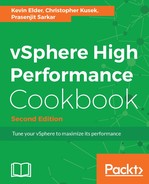VMware vSphere DirectPath I/O leverages Intel VT-d and AMD-Vi hardware support to allow guest operating systems to directly access hardware devices. In the case of networking, vSphere DirectPath I/O allows the VM to access a physical NIC directly rather than using an emulated device or a paravirtualized device. An example of an emulated device is the E1000 virtual NIC, and examples of paravirtualized devices are the VMXNET and VMXNET 3 virtual network adapters. vSphere DirectPath I/O provides limited increases in throughput, but it reduces the CPU cost of networking-intensive workloads.
vSphere DirectPath I/O is not compatible with certain core virtualization features. However, when you run ESXi on certain vendor configurations, vSphere DirectPath I/O for networking is compatible with the following:
- VMware vMotion
- Hot adding and removing of virtual devices, suspend, and resume
- VMware vSphere high availability
- VMware vSphere Distributed Resource Scheduler (DRS)
- Snapshots
Typical VMs and their workloads do not require the use of vSphere DirectPath I/O. However, for workloads that are networking-intensive and do not need the core virtualization features just mentioned, vSphere DirectPath I/O might be useful to reduce CPU usage and/or latency. Another potential use case of this technology is passing through a network card to a guest when the network card is not supported by the hypervisor:

